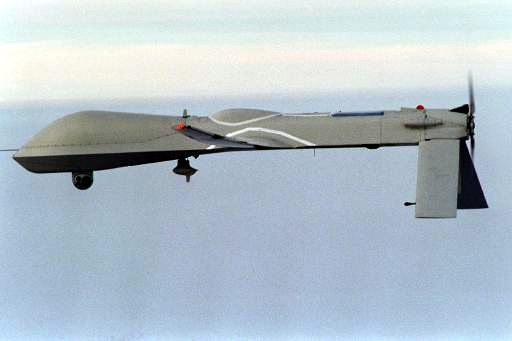Mission
The RQ-1 Predator is a medium-altitude,
long-endurance unmanned aerial vehicle system. It is a
Joint Forces Air Component Commander-owned theater asset
for reconnaissance, surveillance and target acquisition
in support of the Joint Force commander. The Predator
can be employed in moderate risk areas, minimizing the
risk to human life. Examples include areas where enemy
air defenses have not been fully suppressed, open ocean
environments, and biological or chemical contaminated
environments.
Features
The RQ-1A/B Predator is a system, not just an
aircraft. The fully operational system consists of four
air vehicles (with sensors), a ground control station
(GCS), a Predator primary satellite link communication
suite and 55 people.
The Predator air vehicle and sensors are commanded
and controlled by its GCS via a C-band line-of-sight
data link or a Ku-band satellite data link for
beyond-line-of-sight operations. During flight
operations the crew in the GCS is an air vehicle
operator and three sensor operators. The aircraft is
equipped with a color nose camera (generally used by the
air vehicle operator for flight control), a day variable
aperture TV camera, a variable aperture infrared camera
(for low light/night) and a synthetic aperture radar for
looking through smoke, clouds or haze. The cameras
produce full motion video and the synthetic aperture
radar produces still frame radar images. On the RQ-1B,
either the daylight variable aperture or the infrared
electro-optical sensor may be operated simultaneously
with the synthetic aperture radar.
Each Predator air vehicle can be disassembled into
six main components and loaded into a container
nicknamed "the coffin." This enables all
system components and support equipment to be rapidly
deployed worldwide. The largest component is the GCS and
it is designed to roll into a C-130. The Predator
primary satellite link consists of a 20-foot (6.1-meter)
satellite dish and associated support equipment. The
satellite link provides communications between the
ground station and the aircraft when it is beyond
line-of-sight and is a link to networks that disseminate
secondary intelligence. The RQ-1A system needs 5,000 by
125 feet (1,524 by 38 meters) of hard surface runway
with clear line-of-sight to each end from the GCS to the
air vehicles. All components must be collocated on the
same airfield.
The improvements in the RQ-1B include an ARC-210
radio, an APX-100 IFF/SIF with mode 4, an ice mitigation
system, up-graded, turbo-charged engine, and validated
technical orders for operations and maintenance.
Background
The "R" is the Department of Defense
designation for reconnaissance; "Q" means
unmanned aircraft system. The "1" refers to it
being the first of a series of purpose-built unmanned
reconnaissance aircraft systems. The "A" says
it is the pre-production version of the RQ-1 system
series while the "B" denotes the baseline
production configuration.
The Predator system was designed in response to a
Department of Defense requirement to provide persistent
intelligence, surveillance and reconnaissance
information to the warfighter. It was the first
successful advanced concept technology demonstration to
transition to production and fielding. This is a new
acquisition process designed to reduce costs and
development time by relying on commercial off-the-shelf
technology to the maximum extent possible. In April
1996, the Secretary of Defense selected the U. S. Air
Force as the operating service for the RQ-1A Predator
system. The 11th and 15th reconnaissance squadrons,
Indian Springs Air Force Auxiliary Field, Nev.,
currently operate the RQ-1A/B.
General Characteristics
Primary Function: Airborne surveillance
reconnaissance and target acquisition
Contractor: General Atomics Aeronautical Systems
Incorporated
Power Plant: RQ-1A Rotax 912 four cylinder engine
producing 81 horsepower,
RQ-1B 914 four cylinder turbo-charged engine producing
105 horsepower
Length: 27 feet (8.22 meters)
Height: 6.9 feet (2.1 meters)
Weight: 950 pounds (431 kilograms) empty, gross
2,250 pounds (1,020.6 kilograms)
Wingspan: 48.7 feet (14.8 meters)
Speed: Cruise speed around 84 mph (70 knots), up
to 140 mph (120 knots)
Range: up to 400 nautical miles (454 miles) and
then providing 16 hours of on station time before
returning
Ceiling: up to 25,000 feet (7,620 meters)
Fuel Capacity: 665 pounds (100 gallons)
Payload: 450 pounds (204.1 kilograms)
System Cost: $25 million (1999 dollars)
Inventory: Active force, 5; ANG, 0; Reserve, 0
 |